Introduction
Product Overview
{{section_header}}{{section.name}}{{/section_header}}
Meet the V-MODA Remix Remotes, a sleek pair of in-ear headphones.
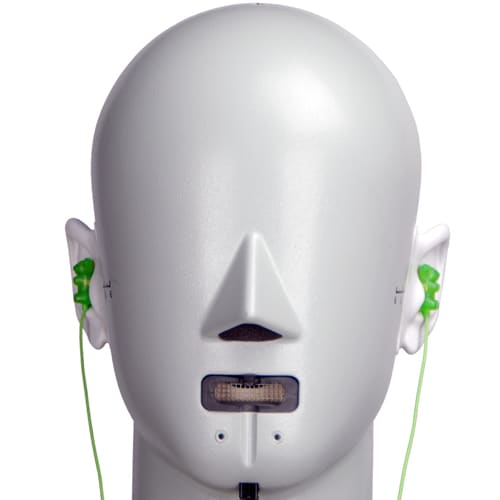
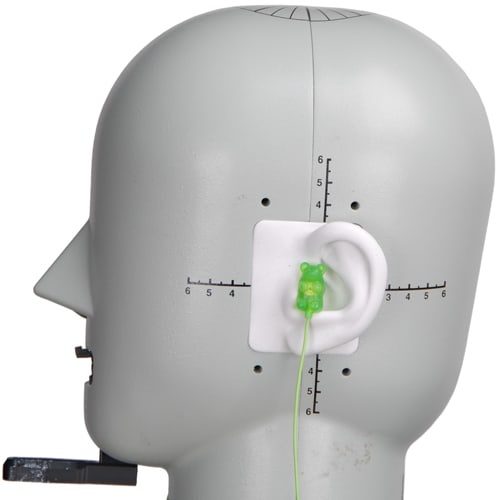
Speakers
{{section_header}}{{section.name}}{{/section_header}}
Here we see the speaker element of the {{product.name}}, which is guarded by a semi-porous mesh. The mesh gate seems to be fine enough to catch most, if not all, bio waste that you could expel.
Cable
{{section_header}}{{section.name}}{{/section_header}}
The cable of the {{product.name}}s are a 3.93 foot long rubber-encased affair that ends in a plug angled at ~45 degrees. As a super-secret special bonus, the base of the plug to the {{product.name}}s has a non-conductive surface, so you won't shock yourself on all the new metal iPod/iPhone devices.
As previously mentioned, the plug to the {{product.model}} is a standard 1/8th brass affair with a non-conductive base.
The cord guards to the {{product.model}}s are somewhat small, so try to avoid tugging your headphones out of your ears by the cord, no matter how tempting it may be; you may end up damaging the internal electronics by breaking the solder points if you do.
In the Box
{{section_header}}{{section.name}}{{/section_header}}
Along with your sleek, metal in-ears, the packaging for the {{product.name}}s comes with 7 additional pairs of sleeves, optional ear loops, and assorted documentation.
Durability
{{section_header}}{{section.name}}{{/section_header}}
In-ears are typically the most fragile of the headphones we review, and these seem to be a little susceptible to wear and tear. Really, much of our distaste for how in-ear headphones are constructed center around how the cable is treated, which is the usually the first thing to break on these headphones. Every solder point becomes a liability when you're shoving these things in your pockets, and even gradual wear and tear from those of us who baby their investment can end in tears.
If your pockets are deep, or your wallet fat, this may not be a big concern for you, but those who want to protect their investment may want to save up to shell out for headphones with detachable earbuds or a replaceable cable. It doesn't sound like much, but it's one of the best steps you can take to make sure that you won't be buying new headphones in short order.
Aesthetics
{{section_header}}{{section.name}}{{/section_header}}
The {{product.name}}s are serious-looking, no-nonsense in-ears that are encased in metal, and don't go out of their way to be unnecessarily flashy. We like this. Though beauty may be in the eye of the beholder, we'll posit that maybe these will have a wide appeal.
Frequency Response
{{section_header}}{{section.name}}{{/section_header}}
Typically, we like to see a flat response here, but different customers like different things in their headphones. For the mass market, and those who like to DJ either in their spare time or professionally, bass-heavy headphones are an attractive option. Looking at the frequency response graph below, you can see that the {{product.name}}s certainly don't skimp on that at all. In addition, the {{product.name}}s also boost the 6-7.5kHz range, which is where most of your cymbal sounds and the middle of your treble tones live. You will have no problem hearing hi-hats or cymbal splash at all.

Click here for more information on our frequency response test.
Distortion
{{section_header}}{{section.name}}{{/section_header}}
The {{product.name}}s have very little distortion, and it's well below the threshhold of human perceptibility. Good job, V-Moda!
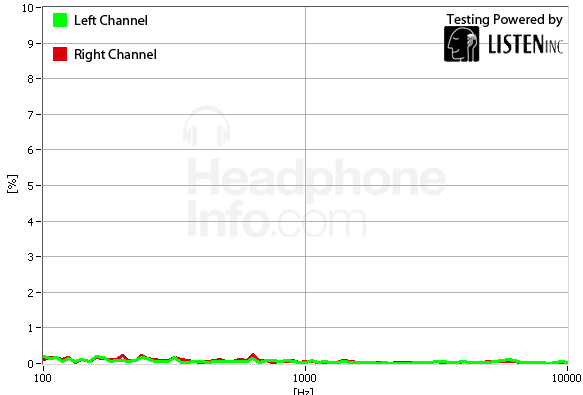
Click here for more information on our frequency response test.
Tracking
{{section_header}}{{section.name}}{{/section_header}}
Though a bit peculiar, the shifts in channel preference along the frequency spectrum are slight at worst, and it is very difficult to hear a 2dB shift in volume. It's not perfect, but we've seen far worse tracking responses.
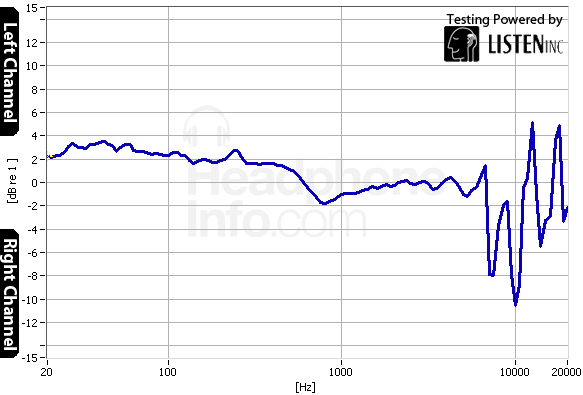
Click here for more information on our frequency response test.
Isolation
{{section_header}}{{section.name}}{{/section_header}}
The typical in-ear headphone user goes out into the noisy world quite often. In many ways, the in-ear design is the ideal choice when you are listening to music outside the home or office as it provides superior noise attenuation and is a little more resilient to weather.
Looking at the graph below, you can see that the {{product.name}}s at worst offer 10dB of noise attenuation in the low end, then gradually block out more sound as it gets closer to 5kHz. All-around, this is a pretty decent result, and will block out a good amount of noise: about the same in the low end as your average ear plugs. If you'd like to know more about sound pressure level, click here.

Click here for more information on our isolation test.
Leakage
{{section_header}}{{section.name}}{{/section_header}}
Despite the typical advantages of the in-ear design, the {{product.name}}s actually do leak a tiny bit of sound. Granted, it's so small that you're unlikely to bother anyone around you in public.
Click here for more information on our leakage test.
Maximum Usable Volume
{{section_header}}{{section.name}}{{/section_header}}
You can crank your {{product.name}}s pretty hard before you make them output a level of 3% distortion, but we like to remind all of our readers that you should never push your headphones this high, due to the possibility that you can damage your hearing permanently.
Click here for more on our maximum usable volume test
Short-Term Use
{{section_header}}{{section.name}}{{/section_header}}
When you consider the fact that in-ear headphones are based off of a design that places them where nothing was ever meant to go into, the {{product.model}} are actually quite comfortable. Not only do they form a good seal on your ear canal with a limited amount of pressure, but the additional ear loops allow you to spread the weight out over your pinna, reducing the force exerted on your soft ear canals.

Extended Use
{{section_header}}{{section.name}}{{/section_header}}
Over a period of 6 hours listening to the {{product.name}}s, the fit didn't change, and they don't move around much at all, so they net the same score here.
Customizability
{{section_header}}{{section.name}}{{/section_header}}
Included in the packaging of the {{product.name}}s are two sets of sleeves, each with 4 different sizes. Though there's not really a great number of crazily flashy things you can do to make these personalized in-ears, the additional sleeves are great for the mass consumer market, as people have many different sizes of ear canals. In addition, the included ear loops allow you to change the wear of the headphones if you want.
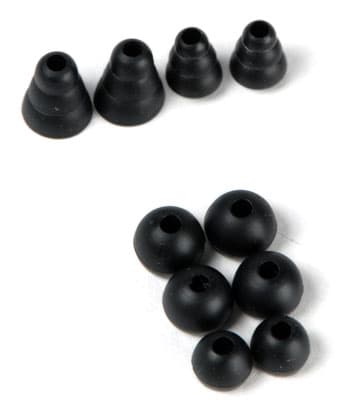
Cable Connectivity
{{section_header}}{{section.name}}{{/section_header}}
There aren't any adapters included with the {{product.name}}s, but that's really not a huge deal unless you want to watch the typically-terrible in-flight movie on an airplane. The {{product.name}}s have a standard 1/8th-inch plug.
Portability
{{section_header}}{{section.name}}{{/section_header}}
With their included carrying bag, the {{product.name}}s go wherever you go: they are easily compacted into the carrying case, and can easily be fit in a pocket or bag. Because they are so small and light, they get high marks for portability.
Other Features
{{section_header}}{{section.name}}{{/section_header}}
Remote & Mic
As their name would suggest, the {{product.name}}s have an in-line remote accessory, with an omnidirectional microphone and buttons for volume control and to answer/end calls. For all those out there that want to use their headphones with their smartphones, this is an important feature.
Design
{{section_header}}{{section.name}}{{/section_header}}
Both headphones are very similar in design, right down to the black and chrome metal housings. There are definitely stylistic differences, but the biggest addition to the Vibratos is the ridiculously robust cable, encased in cloth-wrapped kevlar, those cables will seem virtually indestructible in daily use. They still have the same potential pitfalls with the solder points, but all headphones with remotes have that.
Frequency Response
{{section_header}}{{section.name}}{{/section_header}}
This is about as close as two frequency response graphs can get. Both V-Modas boost bass fairly high, and both have a rather sharp peak at high end of sibilant frequencies and mid-treble tones. The biggest difference, which will be just shy of audible to the mass market consumer, is an ever-so-slight underemphasis of the 5-7kHz range with the Vibratos, but still within our ideal limits.
Distortion
{{section_header}}{{section.name}}{{/section_header}}
Neither headphones had any distortion to write home about, and the response of each looks nearly identical.
Tracking
{{section_header}}{{section.name}}{{/section_header}}
The Vibratos take this one, as they are spot-on for most frequencies, while there are a few minor shifts with the {{product.name}}, but nothing really noticeable.
Isolation
{{section_header}}{{section.name}}{{/section_header}}
both in-ears are good isolators, at worst offering noise attenuation at the same level as earplugs. Both get high marks here.
Comfort
{{section_header}}{{section.name}}{{/section_header}}
Both headphones have very similar designs, and have similar levels of comfort. both are light, and don't put too much pressure on your ear canal, so this one's a wash.
Verdict
{{section_header}}{{section.name}}{{/section_header}}
If you can afford it, what you get when you buy the somewhat more expensive Remix Remotes is crazy durability in your cables. You'll have comparable audio performance and comfort, and very good isolation. You really can't go wrong with either pair here.
Design
{{section_header}}{{section.name}}{{/section_header}}
We don't need to point out that the Sennheiser cans are very different by design, being on-ear active noise cancelers as opposed to the {{product.name}}s, which are in-ears. Still, it's always worth checking out different types of designs to see what suits your tastes more when buying headphones. Though the on-ears sacrifice isolation and portability, they are often more comfortable.
Frequency Response
{{section_header}}{{section.name}}{{/section_header}}
Here we see that the {{product.name}}'s frequency response is very different than that of the Sennheisers. While the V-Modas seem to like their bass emphasis, the Sennhiesers have a much flatter response in the low end. In addition, the Sennheisers have an underemphasis in the high mids to high frequencies that the V-Modas not only preserve, but boost.
Distortion
{{section_header}}{{section.name}}{{/section_header}}
Neither pair of headphones had a significant amount of distortion, but the V-Modas technically have less.
Tracking
{{section_header}}{{section.name}}{{/section_header}}
Despite their small shifts, the {{product.name}}s are certainly less wonky in their channel preferences than the Sennheiser PXC 250-IIs.
Isolation
{{section_header}}{{section.name}}{{/section_header}}
We realize that with a different scale, these headphones look comparable in noise isolation, but they're really not. The {{product.name}}s attenuate much more of the lows and mids you would normally hear in the outside world, which gives the {{product.model}}s a huge advantage in terms of isolation.
Comfort
{{section_header}}{{section.name}}{{/section_header}}
Over-ears and on-ears are typically more comfortable by the very nature of their design, but everybody has a different head! If you have the opportunity, try these on before you buy. It's no secret that comfort can make or break your experience with headphones, so it's important to see what works with you and what doesn't.
Verdict
{{section_header}}{{section.name}}{{/section_header}}
Really, it all depends on your preferences, but the {{product.name}}s have better isolation, decent audio performance with the addition of a lot of bass, and a reduced cost. Obviously comfort will vary from person to person, but if you are looking for a good headset for your phone that won't break the bank, we'd stick with the V-Modas.
Design
{{section_header}}{{section.name}}{{/section_header}}
We don't have to tell you that there are some significant design differences between over-ears and in-ears, but there are some advantages inherent to the designs of each. For example, though in-ears typically are less durable than over-ears, they also offer much more portability and isolation without any fancy active-cancellation systems.
Frequency Response
{{section_header}}{{section.name}}{{/section_header}}
Looking at the frequency response, we notice a few things that that set the Beats and the {{product.model}}s apart: the bass response of the {{product.name}}s and how well the {{product.model}}s stayed within our ideal limits. On the other hand, the Beats seem to have a very erratic response, to the detriment of its score and performance.
Distortion
{{section_header}}{{section.name}}{{/section_header}}
The {{product.name}}s have very little distortion at all, while the beats reach 1% or more in a few places. Hands-down win for the V-Modas here.
Tracking
{{section_header}}{{section.name}}{{/section_header}}
The {{product.name}}s may not be perfect here, but their variances are small and hardly worthy of note. In contrast, the Beats have channel preference shifts up to 10dB in some frequency ranges, which you will definitely hear. Horrible performance from the Beats here.
Isolation
{{section_header}}{{section.name}}{{/section_header}}
Even at their best, the best the Beats can do is sniff a 5dB worse noise reduction than the {{product.name}}s. The scale may make them look comparable, but really, the {{product.name}}s are far better in this regard.
Comfort
{{section_header}}{{section.name}}{{/section_header}}
Here's one that the Beats have over the {{product.model}}s; because they're over-ears, they don't stick anything where it's not supposed to be stuck. That being said, the {{product.name}}s are probably some of the more comfortable in-ears you will find on the market, and you should really try any headphones you are thinking about buying before you purchase them. Comfort can make or break your experience with them, so know what you want before ponying up this kind of cash.
Verdict
{{section_header}}{{section.name}}{{/section_header}}
At a much lower price, the {{product.name}}s offer far superior audio quality, even for bassheads. It's goes without saying that in-ears aren't for everyone, but if you are willing to give it a shot, the {{product.name}}s offer functionality to be used as a headset with smartphones, better audio quality by a longshot, and superior isolation. Really, the only thing that the Beats hold over the V-Modas is brand recognition, and a higher price tag. If you're okay with wearing in-ears, we'd stick with the {{product.name}}s.
Design
{{section_header}}{{section.name}}{{/section_header}}
Though both headphones are in-ears, there are a few key design differences for consumers to think about. Specifically, though the V-Modas are encased in more durable metal, the Sennheisers have detachable earbuds, which allow you to replace their cables, if and when they break. This greatly extends their life expectancy and durability, and even though the V-Modas are more entry-level, the IE 8is are decidedly more mid-range, and features like this are what you can get by shelling out a little bit more cash.
Frequency Response
{{section_header}}{{section.name}}{{/section_header}}
Both frequency response graphs are really quite similar, until you notice that the Sennheisers for whatever reason have a major tracking issue between the left and right channel at 6-10kHz. This one will be noticeable, and make the left channel quite a bit more quiet in that frequency range.
Distortion
{{section_header}}{{section.name}}{{/section_header}}
Sennheiser is famous for making headphones with very little distortion, and the IE 8is continue that trend. Neither pair of headphones have any issues with distortion here, but the IE 8is have less. The difference is nigh inaudible.
Tracking
{{section_header}}{{section.name}}{{/section_header}}
There it is; notice that Sennheisers have a fairly even tracking response, right up until that range we pointed out earlier, where it shifts massively to the right channel for no explicable reason. If you know what you're looking for, you'll definitely hear this one.
Isolation
{{section_header}}{{section.name}}{{/section_header}}
The {{product.name}}s offer better isolation across the board, especially in the high end and in the lowest frequencies.
Comfort
{{section_header}}{{section.name}}{{/section_header}}
Because both are in-ears that gently treat your ear canals right, both are very comfortable for this type of headphone, but you'll just have to try them out for yourself to determine which one will work for you.
Verdict
{{section_header}}{{section.name}}{{/section_header}}
Both are impressive in-ears, but there is a definite upside gained if you shell out for the more-expensive Sennheisers: durability. That's not to say that the metal-ensconced {{product.name}}s aren't durable, but their cables are vulnerable, and can't be replaced. That being said, the drastically reduced cost will be palatable to more consumers, and either way you're getting great value. This one's up to you.
Conclusion
{{section_header}}{{section.name}}{{/section_header}}
V-Moda has produced quite a few impressive headphones at the entry level for consumers, and the {{product.model}}s continue this trend. Given that there is a growing market for headphones that double as smartphone headsets, it's logical to sink a lot of money into getting this type of in-ear out on the market, but there are some small durability concerns with this type of headphone, which V-Moda addresses with the cables on their more expensive Vibrato in-ears.
Use and portability of these headphones in particular is simple and pleasing to the ears, as they don't put as much pressure on the ear canals of its users, all while offering great isolation for the price. Anybody looking to enjoy their music without damaging their hearing should take a good look at these.
The 8 pairs of additional sleeves are a good step towards making sure that these in-ears will fit your soft ear canals well, and the additional ear loops distribute what little weight these buds have over the back of your pinna, to make for as comfortable an experience as you're going to get from in-ear headphones. The included pouch for portability is always a plus, and the omnidirectional mic in the remote allows for seamless transitions from music listening to smartphone calls.
As far as entry-level in-ear headphones go, the $79.99 pricetag is about par for the course, but you do get good value for it. That being said, fans for more analytical headphones with flat bass response and a less dynamic response will probably recoil in horror at the heavily-emphasized low frequencies, but it's a matter of taste, really. There's a large segment of the consumer population that likes this sort of thing, so don't read into the audiophile crowd's lamentations when considering these headphones if you're into that sort of thing.
Meet the tester
A seasoned writer and professional photographer, Chris reviews cameras, headphones, smartphones, laptops, and lenses. Educated in Political Science and Linguistics, Chris can often be found building a robot army, snowboarding, or getting ink.
Checking our work.
Our team is here for one purpose: to help you buy the best stuff and love what you own. Our writers, editors, and lab technicians obsess over the products we cover to make sure you're confident and satisfied. Have a different opinion about something we recommend? Email us and we'll compare notes.
Shoot us an email


